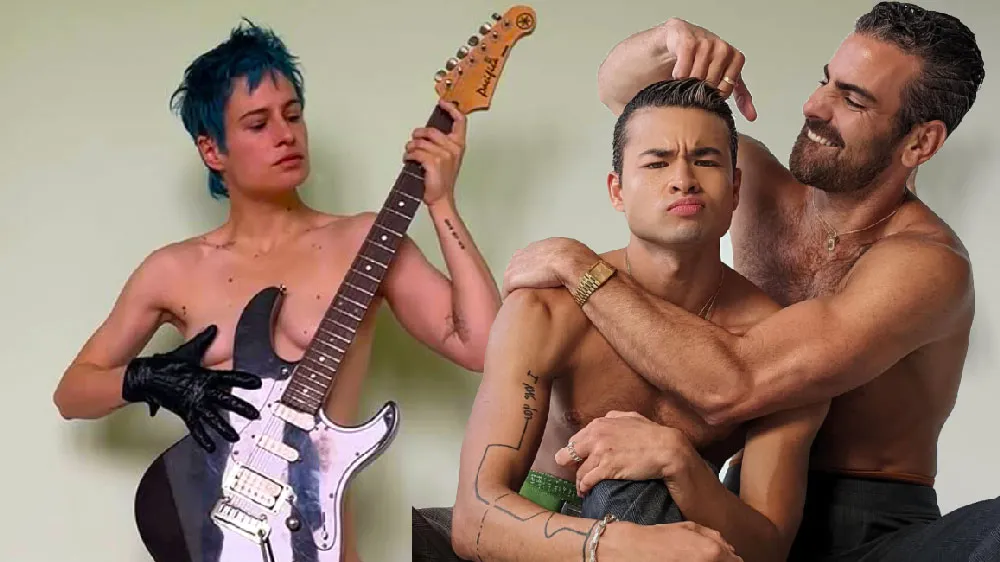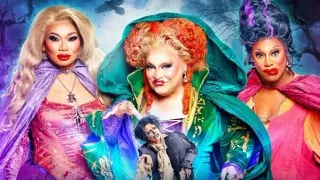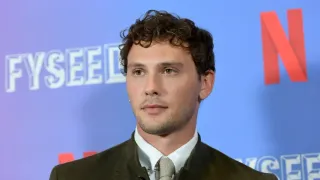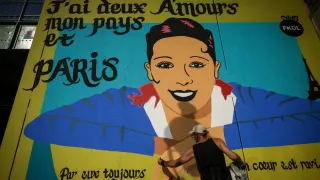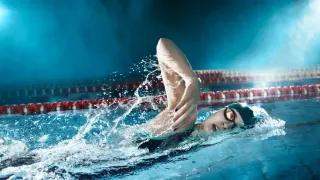November 6, 2021
Prof. Eric Anderson on Growing LGBTQ+ Acceptance from Straight Athletes
Kilian Melloy READ TIME: 10 MIN.
2021 has truly been the year of the LGBTQ+ athlete, both in terms of visibility (think the Tokyo Olympics, with a record number of out competitors. Still, there has sadly been a record-breaking wave of anti-LGTBQ+ legislation that has swept through red state legislatures, much of it targeting transgender youth and, especially, young trans athletes. But in the pro world, it seems like every week or so there's news of still-active athletes bursting out of the closet, from the NFL's Carl Nassib, who came out last June via a low-key Pride Month Instagram post, to the first pro baseball player to come out, Bryan Ruby, publicly embracing his identity (and being followed, not long after, by another pro baseball player, Kieran Lovegrove, who came out as bisexual). It's a far cry from the years when an LGBTQ+ pro athlete kept quiet until well after their prime.
It's tempting to think that we're now reaching a new level of acceptance, but a new study jointly presented by LGBTQ+ athletics site Outsports, the University of Winchester in England, and the Sports Equality Foundation, indicates that this may only be an illusion. Athletes have been growing more accepting not just over the past year or so, but rather over the past several decades.
"A total of 820 different student-athletes submitted 1,000 team coming-out experiences, some reporting on their coming-out experiences on both their high school and college teams," OutSports reported of the new study.
"Only 4.6% of survey respondents said their overall experience coming out to teammates was 'bad' or worse. Conversely, 24.8% – more than five times that number – said the response from teammates was 'perfect or near perfect.' The rest rated their experience between 'neutral' and 'very good.'"
Dr. Eric Anderson, an academic of American origin who is a Professor of Sport, Health, and Social Sciences at the University of Winchester, has been researching this exact topic since the 1990s. His work suggests that even back then, the guys in the locker room were not as opposed to having an LGBTQ+ teammate as stereotypes would have one believe.
The topic is one of natural interest to Anderson, who told EDGE how, "in 1993 I came out of the closet as America's first openly gay high school coach." That experience, in turn, "sent me back to do a Ph.D. on this topic," Anderson added. In the years since, Anderson has published two dozen books and 80 articles. The new study only reconfirms what his work has been telling him for a quarter of a century: Athletes aren't a monolithic block of homophobia that's only now beginning to crack. In fact, the Jon Grudens of the sporting world notwithstanding, the team ethos in team sports is, and has long been, far stronger than anti-gay sentiments.
EDGE found out more in an enlightening chat with Prof. Anderson.
EDGE: Was this study, which was done in conjunction with OutSports, something that they approached you with, or had you thought it up and approached them, or how did that work?
Eric Anderson: I've known Cyd [Zeigler, co-founder and publisher of OutSports] for over 20 years. The reason I partnered up with Cyd on this is because he had resources to be able to do the dirty work of finding the athletes. We avoided going to [UK LGBTQ+ advocacy organization] Stonewall or the other LGBT websites and organizations. We went to high school athletic directors and collegiate athletic directors; we went to websites that are sort of the gatekeepers for swimming, or running, or whatever. It took a lot of man hours, because if I go to a psychology class of 400 students and I say I'm looking for openly LGBT athletes, I'd be lucky to get one. It's a difficult population to find, [but] we've come up with this incredibly large sample size, and you've seen the results: 95% are having "boring" to "fantastic" experiences [when coming out to their teammates].
EDGE: From what you're saying, it sounds like if anti-LGBTQ+ prejudice was in the locker room, it was only because it was there in society in general. As that has decreased in society in general, of course it's also decreased among athletes.
Eric Anderson: I think that in the 1980s, homophobia was the socially accepted perspective on gay people, particularly gay men. I think if you take a gender-segregated arena like sport, that's also invested in masculinity, the rates of homophobia became elevated because of the close contact that they had. But given that they had the ability to be physically close to each other, as homophobia started to wane in the dominant society into the new millennium, they took these what I call homosocial behaviors outside of the sport setting – they took them into clubs and pubs. I argue that the seeds of the modern liberalization of the way boys interact with each other – the softness, the touching, the hugging that straight boys do to each other today, the bromances – actually came from team sport athletes.
EDGE: Your work has been showing for decades that homophobia is far less prevalent in sport than the stereotypes suggest.
Eric Anderson: I've published numerous articles on this topic over the last 20 years. I've consistently examined this issue, both in the United States and in the United Kingdom, so it's an ongoing research project.
I've been showing [for] literally for two decades, now, that when [LGBTQ+] athletes come out to their teams they're having good experiences. And I've shown that those experiences have been upgraded from "good" in 2001 to "fantastic" in 2011, where there was much celebration about their sexual orientation, to today [when] the fanfare is gone because it's not a big deal to youth anymore at all. It's become a non-issue for them.
EDGE: And yet, even now we're presented with that "sport is homophobic" narrative. What accounts for that lag?
Eric Anderson: Despite all of my research [on the attitudes of heterosexual athletes toward LGBTQ+ teammates], the media, and some researchers, have continued to bang this drum that sports are an incredibly homophobic environment.
EDGE: Aside from the media, where does this persistent notion of the athlete as a homophobe come from?
Eric Anderson: There are a few ways to describe this. One is the availability bias; another is what's called "third party perception." I'll give you an example: I was at a Catholic college in the southwest of America, so we're talking Trump country here. I interviewed these guys, and I said, "How would you feel about having a gay athlete on the team?" Every single soccer player that I interviewed said, "I wouldn't have a problem with it, but others would." Everybody's thinking that [a third party] is going to have a problem with it, but actually, no, nobody would.
And also, there's what we call a "negativity bias." If one out of 100 people in a locker room is a jerk, then that colors our whole experience, and we fail to [remember that] 99 people don't care. It's one jerk, but that's what we focus on.
These two variables – the belief that someone else will be homophobic, and if there is one homophobic person, it is sort of a cloud on the whole experience – leads people to say that sports and locker rooms are highly homophobic. But, as we've shown, it's just not the case.
EDGE: When we have something like Jon Gruden's homophobic emails turn up, is this a generational thing because he maybe grew up in the '80s and hasn't made that adjustment in his thinking? Or is he just being a jerk? Or is it more the case that people from a certain generational cohort might throw those words around, and not really connect with what they mean for some people?
Eric Anderson: It's all three. Changing attitudes is [generational], and there's absolutely no question about that. I've been studying attitudes in England for 15 years now; I give my students a survey the minute they come to university, and there's just no homophobia. It's just not out there, [except for] maybe one individual every now and then. Whether you're 18 or 35 today, you've grown up in a culture in which homophobia is not acceptable.
But you get in your 40s, and you've had your teenage years where there is some contestation over this – people were talking about gay marriage and all of that. Get in your 50s, and now you had your adolescence in the 1980s and you grew up socialized to believe that gay people are... name all the pejoratives you want.
So, I think that for this individual, he certainly emerged in that culture. So then, he's socialized into that attitude, and he takes it into an arena that had cultural lag for 10 years; then the new millennium hits, and he senses around him that attitudes have changed, so he doesn't make proclamations out loud anymore. And then, cultural lag hits. Cultural lag is a disassociation between these words and their actual meaning. The best way I can describe it to you is, sometimes people will say, "That's so gay." Clearly, he's homophobic? – No, that's not indicative of his attitude. It's cultural language from a time in which that word had pernicious intent, but it no longer has pernicious intent; it's nonspecific to sexual orientation.
EDGE: How permanent are these gains? If an ebb in homophobia is a sociological phenomenon, then could it come roaring back, especially when we see certain political and faith leaders pushing anti-LGBTQ+ messages?
Eric Anderson: It could, but it would take a structural or other reasons. Let me give an example: Attitudes towards LGBT – not LGB T people, but LGB people – were far better in the 1970s in America than they were in the 1980s. We were making tremendous progress: Disco was this incredibly gay thing, the Village People were very popular. And then HIV [hit] – and that changed everything. And it also hit at the same time that Ronald Reagan melded the Christian right into the political system.
It could change again, absolutely. I don't think it's going to change without a major stimulus. I don't see any antecedent for it to come out of the ether; I don't see it coming just because somebody decides to start spouting homophobia. It isn't going to come from the major purveyors of sport, because the consumer base wouldn't stand for it.
EDGE: Information on what your study says about attitudes toward trans athletes will be forthcoming; are we going to see something fairly similar to the results you got for gay and lesbian athletes, or is there still more of a disconnect when it comes to transgender athletes?
Eric Anderson: I think you'll be shocked. All of the discourse is, "How incredibly contentious this issue is!" But I think that that contention exists amongst media pundits and activists who have nothing to do with sport. Some of it is reflected to the professional level, or at the Olympics sort of level, but at the high school and colleges where these people have transgender friends, why would it be an issue? I think the data will speak clearly to the wonderful sort of dispositions that youth take towards gender and sexual orientation, and inclusivity... it's not an issue for them.
EDGE: Your work has shown over 20 years or longer that attitudes have changed and changed rapidly, yet it's only been this last summer, with the games in Tokyo, that we've more or less had a "Rainbow Olympics." And it's only been this last summer that we've seen Carl Nassib come out, two professional baseball players come out, British cyclists have come out – there's been a wave. Are we at a tipping point?
Eric Anderson: Well it's not a tipping point, and there never will be a tipping point. If you just look at gay men, for example, we're about 3% of the general population. That's it. And despite all of the gains we've had, we are not seeing more people come out of the closet – on national surveys, that's not rising. And we're not seeing an improvement in measures of mental health, either. But what we do see is, obviously, more social acceptance.
Okay, so, 3% [of the general population] are gay. How many gay men are actually attracted to football, baseball, and basketball? And how many other gay men are absolutely not interested in sports whatsoever? The answer is, not many. Our numbers aren't 3% [of the people who are serious about athletics], and 3% of NFL players are not going to be gay.
So, is this currently a watershed moment? I don't think this is any better than what we had in 2014, when we had Michael Sam, we had Jason Collins come out in the NBA, and a few others. There was this sort of wave then, but I don't think we're ever going to see a tipping point.
Kilian Melloy serves as EDGE Media Network's Associate Arts Editor and Staff Contributor. His professional memberships include the National Lesbian & Gay Journalists Association, the Boston Online Film Critics Association, The Gay and Lesbian Entertainment Critics Association, and the Boston Theater Critics Association's Elliot Norton Awards Committee.
